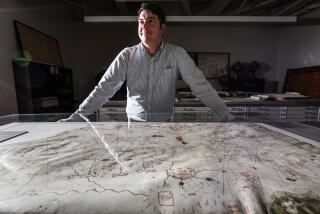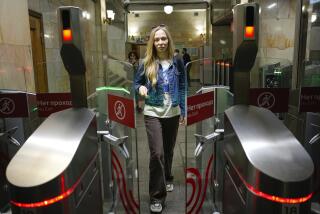Moscow to Place Nation on Right Road After Faking Maps for 50 Years
- Share via
MOSCOW — When a Russian says, “You can’t get there from here,” he is probably looking at a Soviet map.
Soviet map makers now acknowledge that for 50 years, they have methodically distorted all of the country’s published maps on orders from the security police.
Roads and rivers were shifted miles from where they actually were, cities were moved and some towns were left off entirely. Mountains grew in height, lakes shrank in size and some big urban areas were described as little more than rural settlements.
On city maps, prominent buildings and major landmarks were omitted, street names were switched around and incorrect house numbers were given.
Most Soviet maps, in fact, distorted the whole scale so that--quite deliberately--there was no certainty on how far anything was from anything else.
The purpose of what for a map maker would seem like madness was to deceive the Soviet Union’s enemies, says the country’s chief cartographer, Viktor R. Yashchenko.
Yashchenko, head of the government’s Main Administration of Geodetics and Cartography, announced plans Saturday to issue the first accurate maps in half a century and to publish a full Soviet atlas within two years.
“All places, points and other information will be shown where they really area,” Yashchenko declared, saying that the decision had been approved as part of the government’s implementation of glasnost, or political openness.
For Soviet map makers, this task is now almost a matter of honor, because the only accurate maps of the country in public use are based on those issued by the CIA, which even publishes a popular Moscow street guide--again the only one available.
Yashchenko told the government newspaper Izvestia last week that “masses of complaints” about existing Soviet maps had been received. “People could not recognize their motherland on the map, and tourists tried in vain to figure out where they were,” he said.
Even on the principal tourist map of Moscow published here, Yashchenko said, “the contours of the capital are only partly accurate.”
The dictator Josef Stalin, anticipating the country’s invasion by Nazi Germany, first ordered the distortions in the late 1930s and put the map makers under the control of the security police, then known as the NKVD from its Russian initials.
Later, from the start of the Cold War, the distortions were extended and refined to deceive bomber pilots trying to find their targets.
“The atmosphere of mistrust and espionage was reflected on the output of cartographers as well,” Yashchenko said, recalling the paranoia of the Stalinist Era. “Even in the post-Stalin period, the distortion of generally available maps continued as a requirement of our administration.”
Soviet cartographers did make accurate maps for government use, Yashchenko said, but almost all were classified as secret and protected by armed guards. Disclosure of any information on those restricted maps, such as the correct location of a road or the proper name of a city district, could be punished under Soviet law by prison sentences of up to eight years.
A former “map guard” described the job--and by implication the whole effort at secrecy--as absurd in a recent letter to the newspaper Soviet Russia.
“I kept the maps under lock and key,” he said, recalling his 20-year career in “topography.”
“Twice a year, a commission would come to check the huge stacks of maps, page by page, and after all the word secret was written on each one. For those who have witnessed this, they know what a labor-intensive, exhausting and useless job it is. But that is the way things are done.”
The effort grew increasingly absurd, Yashchenko said, with the advent of space photography and the ability of high-resolution cameras on American reconnaissance satellites to map the country with detailed photographs.
“The universal mania for secrecy in this era of satellite surveying has lost all sense,” he said.
The Soviet subterfuge had, in fact, been discovered years ago, even before the refinement of satellite photography made it possible to read the license plate on a car.
Theodore Shabad, a longtime reporter and editor at the New York Times and the editor of the American journal Soviet Geography, noticed in the 1960s while comparing new Soviet atlases to old maps that cities and rivers whose locations had long been known appeared to have been moved by as much as 200 miles.
The more Shabad checked, the more discrepancies he found, even among the various Soviet maps. Some cities moved with each edition, some towns disappeared one year and then returned in a later edition, and railways and frontier settlements whose construction had been described in almost heroic terms in the Soviet press often were not indicated at all.
Yashchenko said that the first step had already been taken to correct the situation with the compilation of a basic, highly detailed 240,000-page atlas of the country for the use of geographers and surveyors.
The first accurate map for circulation was issued last week. Another map will be issued later this year. By 1991, new maps of all the country’s republics and regions will have been published.
More to Read
Sign up for Essential California
The most important California stories and recommendations in your inbox every morning.
You may occasionally receive promotional content from the Los Angeles Times.










